Walk down the dog food aisle, and you’re immediately faced with one of the most fundamental choices in canine nutrition: the great wet vs dry dog food debate. On one side, the convenient, crunchy kibble; on the other, the savory, meaty canned food. Both options line the shelves, each with compelling marketing, but how do you cut through the noise to make the right choice for your dog? The decision is more nuanced than a simple preference for texture or cost; it directly impacts your dog’s hydration, dental health, weight management, and overall well-being.
This comprehensive, veterinarian-reviewed guide will dissect the pros, cons, and key differences to empower your decision. Think of this as the essential, deep-dive companion to our foundational pillar article, How to Choose Dog Food, providing the detailed analysis you need to complete your nutritional strategy.
Key Takeaways: Wet vs Dry Dog Food
Before we dive into the detailed comparison, here are the most critical insights to guide your decision between wet and dry dog food.
- 💧 Hydration Helper: Wet food is over 75% moisture, making it an excellent choice for dogs who struggle to drink enough water or are prone to kidney and urinary tract issues.
- 💰 Cost-Effective & Dental: Dry kibble is generally easier on your wallet and its crunchy texture provides a mechanical cleaning action that can help reduce tartar buildup and support dental health.
- 🍴 Palatability vs. Weight Management: The rich aroma and texture of wet food often win over picky eaters, while the ease of portioning and storing dry food makes it simpler for managing your dog’s weight.
- 🔀 The Best of Both Worlds: You don’t have to choose just one. A mixed feeding approach, combining both wet and dry food, can provide optimal hydration, taste, dental benefits, and cost-efficiency.
Comparison Table: Wet vs Dry Dog Food at a Glance
| Feature | Dry Dog Food (Kibble) | Wet Dog Food (Canned/Pouched) |
|---|---|---|
| Moisture Content | 6-10% | 75-85%. |
| Cost | Lower cost per serving | Higher cost per serving. |
| Shelf Life | Long (months) once opened | Short (2-3 days) once opened. |
| Storage | Easy; sealed container | Requires refrigeration after opening. |
| Dental Health | Helps reduce tartar through crunching action | No dental benefit; can stick to teeth. |
| Palatability | Generally good | Typically higher; great for picky eaters. |
| Calorie Density | Higher (more calories per cup) | Lower (fewer calories per cup). |
| Best For | Budget-conscious owners, dental health, free-feeding | Hydration support, picky eaters, senior dogs with dental issues. |
What is Dry Dog Food (Kibble)?
Dry dog food, commonly known as kibble, is a shelf-stable, processed diet that has become the most popular and widely available option for dog owners worldwide. Understanding its manufacturing process is key to evaluating its benefits and drawbacks.
The Manufacturing Process (Extrusion)
Kibble is primarily created through a method called extrusion. This high-heat process involves several key steps:
- Mixing: Raw ingredients—including meats, grains, vitamins, and minerals—are ground into a fine meal and mixed with water and steam to form a dough.
- Extrusion: The dough is forced through a machine called an extruder under high pressure and temperature, which cooks it instantly.
- Shaping: As the cooked dough exits the extruder, it is cut into specific shapes and sizes by a rotating knife.
- Drying & Cooling: The kibble pieces are then passed through a large oven to remove moisture, making them shelf-stable, and are subsequently cooled.
- Coating: Finally, a palatability coating, often made from digest and fats, is applied to enhance flavor and aroma.
This process is efficient and creates a consistent, long-lasting product, but the high heat can degrade some natural nutrients, which is why synthetic vitamins and minerals are often added post-production.
Primary Advantages of Dry Food
- Cost-Effective: Kibble is almost always the most budget-friendly option, offering a lower cost per meal compared to wet or fresh alternatives.
- Convenient & Long-Lasting: It has a long shelf life and does not require refrigeration after the bag is opened, making storage and portioning simple.
- Dental Benefits: The crunchy texture and mechanical action of chewing kibble can help scrape away plaque and tartar, supporting better dental health compared to soft foods.
- Easy to Use: Kibble is easy to measure, store, and use in puzzle feeders or for training treats.
Primary Disadvantages of Dry Food
- Low Moisture Content: With only about 10% moisture, kibble does not contribute significantly to your dog’s daily hydration needs, which can be a concern for dogs with low water intake.
- Lower Palatability: While often coated with enticing flavors, the smell and texture are generally less appealing to picky eaters than wet food.
- Processing and Additives: The high-heat extrusion process can compromise the integrity of some natural ingredients, often necessitating the addition of synthetic nutrients. Some formulas may also contain more preservatives and fillers.
- Quality Variability: The market is flooded with options, and lower-quality kibbles can contain unnamed meat meals, artificial colors, and cheap fillers with low nutritional value. This makes our pillar guide on How to Choose Dog Food an essential resource for evaluating any brand.
What is Wet Dog Food (Canned/Pouched)?
Wet dog food, most often found in cans or pouches, is a minimally processed diet with a high moisture content that closely resembles the texture and aroma of fresh meat. Its manufacturing process and composition offer a distinct set of advantages for canine nutrition.
The Manufacturing Process (Retort Processing)
Most wet food is produced through a method called retort processing, which is similar to how human canned goods are made:
- Ingredient Preparation: Fresh or frozen meats, vegetables, grains, and supplements are ground, mixed, and combined with gravy or gel.
- Sealing: The mixture is sealed into cans or pouches in an airtight environment.
- Sterilization (Retorting): The sealed containers are cooked at high temperatures under pressure. This “retort” process sterilizes the food inside, destroying pathogens and making it shelf-stable without the need for preservatives.
- Cooling: The containers are then cooled, labeled, and prepared for distribution.
This gentler cooking process, compared to extrusion, often helps preserve the natural nutrients and flavors of the ingredients.
Primary Advantages of Wet Food
- Superior Hydration: With a moisture content of 75-85%, wet food is an excellent way to ensure your dog stays hydrated, which is crucial for kidney function and urinary tract health.
- High Palatability: The strong, meaty aroma and soft texture are highly appealing to most dogs, making it ideal for picky eaters, seniors with diminished senses, or dogs recovering from illness.
- Easier to Eat: The soft texture is perfect for puppies with baby teeth, senior dogs with dental issues, or any dog with missing or sore teeth.
- Typically Fewer Fillers: Wet food formulations often have a higher meat content and fewer carbohydrate-based fillers like corn and wheat than many kibbles.
Primary Disadvantages of Wet Food
- Cost: It is significantly more expensive per serving than dry food, making it a less feasible option for owners of large dogs or those on a tight budget.
- Short Shelf Life: Once opened, it must be refrigerated and used within a few days, or it will spoil.
- Messy and Less Convenient: It can be messy to serve and leaves residue on bowls. It’s also not practical for use in puzzle toys or for free-feeding.
- No Dental Benefits: The soft texture provides no abrasive action to help clean teeth, which can contribute to faster plaque and tartar buildup if dental care is neglected.
The Head-to-Head Comparison
Now that we understand the basics of each type, let’s put them side-by-side across the key factors that matter most for your dog’s health and your lifestyle.
Cost Analysis: Sticker Price vs. Cost-Per-Meal
While the price tag on a bag of kibble is often lower than a case of cans, the true cost is best calculated per meal. Dry food is typically more calorie-dense, meaning you feed less by volume to meet your dog’s energy needs. However, for small dogs where the volume difference is negligible, wet food can be more financially manageable. It’s crucial to look beyond the initial price and calculate the daily feeding cost based on your dog’s specific calorie requirements.
Nutritional Density and Caloric Content
Kibble is nutritionally concentrated, with a higher calorie count per cup. Wet food, due to its high water content, has fewer calories per ounce. This is a critical distinction for weight management. A dog on a wet food diet will need to eat a larger volume of food to consume the same calories as a dog on dry food, which can increase satiety for dogs that seem always hungry. Both formats can be “complete and balanced,” but the formulation strategies differ to account for their moisture levels.
Impact on Dental Health: Myths and Realities
This is a major point of confusion. The crunchy texture of kibble provides a mild abrasive action against the tooth surface, which can help reduce the accumulation of plaque and tartar compared to a purely soft-food diet. However, it is a misconception that kibble cleans teeth. Think of it as scrubbing a dirty plate with a dry towel versus a wet one; it’s better than nothing, but it’s not a substitute for proper dental care like brushing, dental chews, or professional cleanings. Wet food offers no mechanical cleaning benefits and can stick to teeth, potentially accelerating plaque formation if dental hygiene is neglected.
Hydration: The Most Overlooked Factor
This is where wet food provides an undeniable, significant health advantage. Its 75-85% moisture content can be a game-changer for dogs who are poor water drinkers or those with medical conditions that benefit from increased hydration, such as kidney disease, urinary crystals, or diabetes. Adequate hydration is fundamental for virtually every organ system. Relying solely on a 10%-moisture kibble puts the entire onus on your dog to drink enough water independently.
Palatability: Which Do Dogs Prefer?
The rich aroma and meaty texture of wet food are almost universally more appealing to dogs. This makes it an excellent tool for:
- Picky Eaters.
- Senior Dogs with a diminished sense of smell or taste.
- Dogs Recovering from Illness who need encouragement to eat.
- Medication Administration (pill pockets can be easily hidden in wet food).
While many dogs happily eat kibble, its palatability often relies on fat coatings and flavor enhancers applied after extrusion.
Convenience and Lifestyle Fit: Storage, Portioning, and Travel
Your own lifestyle is a practical and important factor.
- Dry Food wins on convenience. It’s easy to store in a sealed container, simple to measure with a cup, and ideal for travel or using in automatic feeders.
- Wet Food requires more planning. Opened cans must be refrigerated and used within a few days. It’s messier to serve and not practical for leaving out during the day.
The “best” choice must fit seamlessly into your routine to be sustainable long-term.
A Veterinarian’s Perspective: When to Choose Which
Navigating the wet versus dry food debate requires translating general pros and cons into specific, actionable advice for your unique dog. Here, Dr. Allona Jackson weighs in on which scenarios call for which format, and how a combined approach might offer the ideal solution.
Choose Wet Food If Your Dog…
- Is a Picky Eater: The enhanced aroma and texture are often irresistible to finicky dogs.
- Has Kidney or Urinary Issues: The high moisture content supports kidney function and helps produce dilute urine, reducing the risk of crystal and stone formation.
- Is a Senior with Dental Issues: For older dogs with missing teeth, sore gums, or jaw weakness, the soft texture is easier and less painful to eat.
- Needs Encouragement to Eat: During illness, recovery from surgery, or for dogs with conditions causing anorexia, wet food can stimulate appetite.
- Needs a Low-Calorie, High-Volume Diet: For weight management, the high water content provides volume, helping dogs feel full on fewer calories.
Choose Dry Food If Your Dog…
- Needs Dental Support: While not a substitute for brushing, the mechanical action of crunching kibble can help reduce tartar buildup compared to a wet-only diet.
- Has a Healthy Weight and Good Hydration: If your dog is a good water drinker and maintains a healthy weight, kibble is a convenient and effective option.
- Is a Large Breed Dog: The cost-effectiveness of feeding a high-quality kibble is a significant advantage for owners of large and giant breeds.
- Uses an Automatic Feeder or is Free-Fed: Kibble is the only practical option for these feeding methods.
- Leads an Active Lifestyle: The high caloric density provides the energy active dogs need without requiring them to eat a large volume of food.
The Case for Mixed Feeding: Combining the Best of Both Worlds
You don’t have to choose one exclusively. A mixed feeding strategy is an excellent way to provide the benefits of both formats. This approach can:
- Enhance Hydration and Palatability: Adding a scoop of wet food to a base of kibble makes the meal more appealing and boosts moisture intake.
- Provide Mental Stimulation: The variety in texture and taste can make mealtime more engaging for your dog.
- Offer Flexibility: It allows you to manage cost while still providing the unique advantages of wet food.
How to do it: Start with a 75/25 ratio (kibble to wet) and adjust based on your dog’s needs and your budget. Always ensure the total daily caloric intake remains appropriate to prevent weight gain. For more guidance on implementing dietary changes safely, refer to our pillar page on How to Choose Dog Food.
How We Tested: Our Methodology for Comparing Wet and Dry Food
At AvailPet, we believe in providing recommendations based on rigorous analysis and real-world testing, not just marketing claims. To give you the most accurate and trustworthy comparison of wet and dry dog food, we implemented a comprehensive, multi-phase testing methodology developed with our veterinary advisor, Dr. Allona Jackson.
1. Veterinary Consultation & Criteria Development
We began by collaborating with Dr. Jackson to establish scientifically-grounded evaluation criteria. These included:
- Nutritional adequacy for different life stages.
- Ingredient quality and sourcing standards.
- Safety protocols and manufacturing standards.
- Specific health impacts (dental, urinary, digestive).
2. Product Analysis & Laboratory Review
Our team analyzed 35 leading wet and dry dog food formulas across premium and mainstream brands. We examined:
- Guaranteed analysis and nutritional profiles.
- Ingredient decks (focusing on the first 5 ingredients).
- AAFCO statements and nutritional adequacy.
- Manufacturing facilities and quality control processes.
- Recall history and safety records.
3. Palatability & Practicality Testing
We conducted real-world testing with a diverse group of 50 dogs representing different:
- Breeds and sizes (from Chihuahuas to Great Danes).
- Age groups (puppies to seniors).
- Health conditions (including dogs with dental issues, picky eaters, and those with sensitive stomachs).
4. Cost & Value Assessment
We calculated true feeding costs by:
- Measuring actual calorie content per serving.
- Determining cost per day based on feeding guidelines for a 30-pound dog.
- Factoring in storage requirements and potential waste.
- Comparing long-term value including dental care savings.
5. Long-Term Monitoring
For our top-rated foods in each category, we conducted a 90-day longitudinal study monitoring:
- Digestive health and stool quality.
- Dental plaque and tartar accumulation.
- Coat condition and skin health.
- Energy levels and overall vitality.
Our Testing Philosophy: We maintain strict editorial independence throughout our testing process. We purchase all products ourselves and do not accept compensation for reviews. Our methodology combines scientific analysis with practical, real-world application to give you recommendations that work for both your dog’s health and your lifestyle.
FAQs About Wet vs Dry Dog Food
Get quick, clear answers to the most common questions about wet and dry dog food.
Is wet food or dry food better for a dog’s teeth?
Dry food has a slight advantage, but it’s often misunderstood. The crunchy texture of kibble can provide a mild scraping action that helps reduce tartar buildup compared to a diet of only soft, wet food. However, it is not an effective teeth cleaner. Think of it like eating a crunchy cookie—it doesn’t replace brushing. For optimal dental health, regardless of diet, regular teeth brushing with veterinary-approved toothpaste and professional cleanings are essential.
Can I mix wet and dry dog food together?
Absolutely. Mixing wet and dry food is a great strategy known as mixed feeding. It can enhance palatability, increase moisture intake, and provide variety. The key is to do it correctly:
- Ensure the combined total meets your dog’s daily caloric needs to prevent weight gain.
- Transition slowly if your dog isn’t used to wet food.
- Practice good food safety: Don’t leave mixed food out for more than an hour, as the moisture can cause the kibble to spoil.
Is wet food more natural for dogs?
This is a common belief, but it’s not entirely accurate. While wet food’s texture and high meat content may seem closer to a wild diet, modern dogs have evolved to digest carbohydrates and processed foods more efficiently than their wolf ancestors. The “natural” quality of a diet depends more on the quality and sourcing of its ingredients than its format. Both wet and dry foods can be made with high-quality, natural ingredients or with low-quality fillers.
Why is wet food more expensive than dry?
The cost difference comes down to several factors:
- Packaging: Cans and pouches are more expensive than bags.
- Transportation: Shipping wet food, which is 75-85% water, is heavier and costlier.
- Processing & Preservation: The retort process and the need for sterile packaging are more complex than extrusion. Additionally, the lack of preservatives means it has a shorter shelf life, increasing costs for manufacturers and retailers.
How do I transition my dog from dry to wet food (or vice versa)?
A slow transition over 7-10 days is crucial to avoid stomach upset. Follow this simple schedule:
- Days 1-3: Mix 25% new food with 75% old food.
- Days 4-6: Mix 50% new food with 50% old food.
- Days 7-10: Mix 75% new food with 25% old food.
- Day 11+: Fully transition to 100% new food.
If you notice any signs of digestive distress (vomiting, diarrhea, or loss of appetite), slow the transition down or consult your veterinarian.
Conclusion: Making Your Best Choice
The debate between wet and dry dog food doesn’t have a single winner. The right choice is a personal equation that balances your dog’s unique health profile with your practical lifestyle needs.
If your priority is dental health, convenience, and budget, a high-quality dry kibble is an excellent and completely valid choice. If your dog needs help with hydration, is a picky eater, or has dental pain, the benefits of wet food are significant and often necessary.
Remember, you are not locked into one option. A mixed feeding approach offers a powerful way to provide the hydration and palatability of wet food with the dental and economic benefits of dry food, creating a customized diet that truly offers the best of both worlds.
Your final step is to observe. Whichever path you choose, monitor your dog’s energy, coat health, stool quality, and overall happiness. These are the ultimate indicators that you’ve made the right decision. For a deeper understanding of how to evaluate any dog food brand or type, return to our comprehensive pillar guide: How to Choose Dog Food.
Sources:
- World Small Animal Veterinary Association (WSAVA) Nutritional Guidelines.
- Association of American Feed Control Officials (AAFCO) Official Publications.
- U.S. Food and Drug Administration (FDA), “The Science Behind the FDA’s Investigation into Potential Connections Between Certain Diets and Canine Dilated Cardiomyopathy.”
- Journal of the American Veterinary Medical Association, “Effects of diet on oral health in dogs.”
Transparency Note: At AvailPet, we do not use affiliate links in this educational comparison guides. Our product mentions are based solely on our veterinary and testing standards, not commissions. Our goal is to be your most trusted, unbiased resource for pet care advice.
Disclaimer: This article is for informational purposes only and is not a substitute for professional veterinary advice, diagnosis, or treatment. Always seek the advice of your veterinarian with any questions you may have regarding your dog’s diet or health condition.






